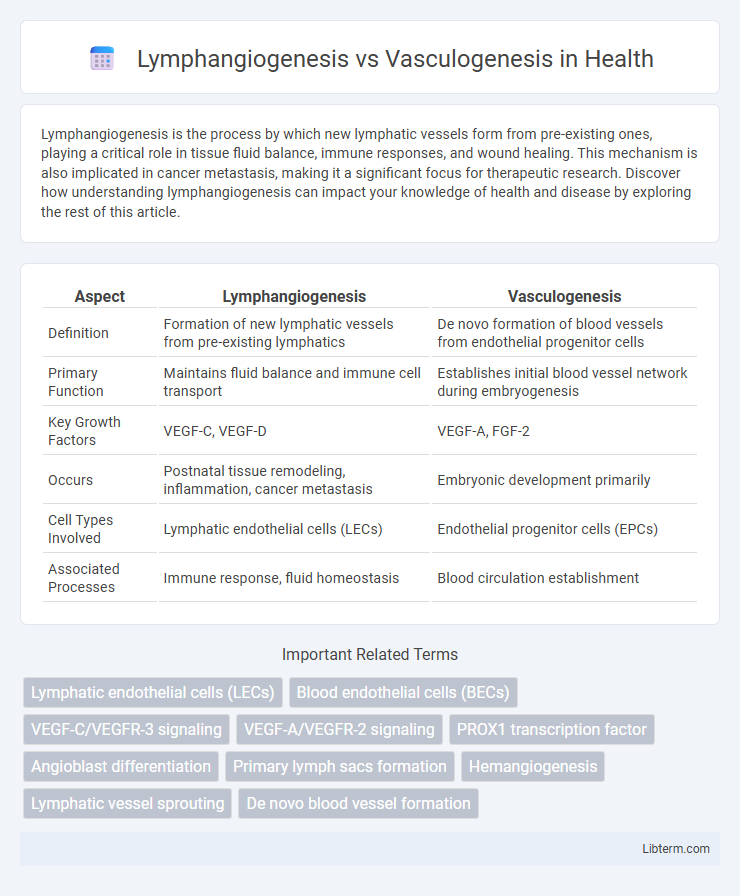Lymphangiogenesis is the process by which new lymphatic vessels form from pre-existing ones, playing a critical role in tissue fluid balance, immune responses, and wound healing. This mechanism is also implicated in cancer metastasis, making it a significant focus for therapeutic research. Discover how understanding lymphangiogenesis can impact your knowledge of health and disease by exploring the rest of this article.
Table of Comparison
| Aspect | Lymphangiogenesis | Vasculogenesis |
|---|---|---|
| Definition | Formation of new lymphatic vessels from pre-existing lymphatics | De novo formation of blood vessels from endothelial progenitor cells |
| Primary Function | Maintains fluid balance and immune cell transport | Establishes initial blood vessel network during embryogenesis |
| Key Growth Factors | VEGF-C, VEGF-D | VEGF-A, FGF-2 |
| Occurs | Postnatal tissue remodeling, inflammation, cancer metastasis | Embryonic development primarily |
| Cell Types Involved | Lymphatic endothelial cells (LECs) | Endothelial progenitor cells (EPCs) |
| Associated Processes | Immune response, fluid homeostasis | Blood circulation establishment |
Introduction to Lymphangiogenesis and Vasculogenesis
Lymphangiogenesis is the process of forming new lymphatic vessels from pre-existing lymphatic vessels, playing a crucial role in immune function and fluid homeostasis. Vasculogenesis refers to the de novo formation of blood vessels from endothelial progenitor cells during embryonic development, essential for establishing the primary vascular network. Both processes involve distinct cellular origins and molecular signaling pathways, with lymphangiogenesis being driven predominantly by VEGF-C/VEGFR-3 signaling and vasculogenesis regulated by VEGF-A and its receptors.
Defining Lymphangiogenesis: Key Concepts
Lymphangiogenesis is the process of forming new lymphatic vessels from pre-existing ones, essential for maintaining fluid homeostasis and immune function. Key markers involved include VEGF-C and VEGF-D, which activate VEGFR-3 receptors on lymphatic endothelial cells to promote vessel sprouting. Unlike vasculogenesis, which generates blood vessels de novo from endothelial progenitor cells during embryogenesis, lymphangiogenesis occurs primarily in postnatal tissues to support lymphatic system remodeling and repair.
Understanding Vasculogenesis: Basic Overview
Vasculogenesis is the process by which new blood vessels form from endothelial progenitor cells during embryonic development, providing the initial vascular network. It differs from lymphangiogenesis, which involves the formation of lymphatic vessels from pre-existing lymphatic endothelial cells. Understanding vasculogenesis is crucial for insights into cardiovascular development and potential therapeutic strategies for vascular diseases.
Molecular Mechanisms in Lymphangiogenesis
Lymphangiogenesis involves the formation of new lymphatic vessels from pre-existing lymphatic endothelium, primarily regulated by VEGF-C and its receptor VEGFR-3, which activate signaling pathways such as PI3K/Akt and ERK to promote lymphatic endothelial cell proliferation and migration. Key molecular players include the transcription factor PROX1, which maintains lymphatic endothelial cell identity, and LYVE-1, a lymphatic marker involved in vessel maturation. In contrast, vasculogenesis entails the de novo formation of blood vessels from endothelial progenitor cells during embryogenesis, driven mainly by VEGF-A and its receptor VEGFR-2.
Signaling Pathways in Vasculogenesis
Vasculogenesis involves the formation of new blood vessels from endothelial progenitor cells, primarily regulated by signaling pathways such as VEGF (vascular endothelial growth factor), Notch, and BMP (bone morphogenetic protein). The VEGF pathway plays a crucial role by promoting endothelial cell differentiation and migration, while Notch signaling controls arterial-venous specification and vascular patterning. BMP signaling contributes to mesodermal progenitor cell commitment and vascular stability during early vasculogenesis.
Key Differences Between Lymphangiogenesis and Vasculogenesis
Lymphangiogenesis involves the formation of new lymphatic vessels from pre-existing lymphatic endothelium, primarily driven by VEGF-C and VEGF-D signaling pathways, whereas vasculogenesis refers to the de novo formation of blood vessels from endothelial progenitor cells during embryonic development. Lymphangiogenesis plays a crucial role in immune function and fluid homeostasis, while vasculogenesis is essential for establishing the primary vascular network in the embryo. Unlike vasculogenesis, which occurs predominantly during early developmental stages, lymphangiogenesis continues to occur postnatally in response to inflammation, wound healing, and tumor growth.
Physiological Roles in Health and Development
Lymphangiogenesis involves the formation of new lymphatic vessels from pre-existing ones, playing a crucial role in maintaining fluid homeostasis, immune surveillance, and fat absorption during health and development. Vasculogenesis refers to the de novo formation of blood vessels from endothelial progenitor cells, essential for embryonic development and the establishment of the primary vascular network. Both processes coordinate to ensure tissue growth, repair, and proper organogenesis by facilitating nutrient delivery and immune cell trafficking.
Lymphangiogenesis and Vasculogenesis in Disease
Lymphangiogenesis refers to the formation of new lymphatic vessels from pre-existing lymphatics, playing a crucial role in immune response, cancer metastasis, and inflammatory diseases by facilitating lymphatic drainage and trafficking of immune cells. Vasculogenesis involves the de novo formation of blood vessels from endothelial progenitor cells, critical for embryonic development and tissue repair but also contributing to tumor growth and ischemic diseases through neovascularization. Dysregulated lymphangiogenesis can promote tumor lymphatic invasion and chronic inflammation, while aberrant vasculogenesis supports pathological angiogenesis, underscoring their distinct yet intersecting roles in disease progression and therapeutic targeting.
Therapeutic Implications and Targeted Treatments
Targeted treatments in lymphangiogenesis aim to modulate lymphatic vessel growth for conditions like lymphedema and cancer metastasis, primarily by influencing VEGF-C/VEGFR-3 signaling pathways. Vasculogenesis-based therapies focus on promoting the formation of new blood vessels from endothelial progenitor cells, crucial for tissue regeneration and ischemic disease treatment through factors such as VEGF-A and angiopoietins. Understanding the distinct molecular mechanisms of lymphangiogenesis versus vasculogenesis enables the development of precise therapeutic interventions tailored to vascular and lymphatic pathologies.
Future Directions in Vascular and Lymphatic Research
Future directions in vascular and lymphatic research emphasize advanced molecular profiling techniques to distinguish lymphangiogenesis from vasculogenesis at cellular and genetic levels. Cutting-edge imaging modalities and single-cell RNA sequencing are being leveraged to map the spatiotemporal dynamics of endothelial progenitor cells during vessel formation. Integration of bioinformatics and artificial intelligence aims to uncover novel signaling pathways and therapeutic targets for regenerative medicine and cancer metastasis inhibition.
Lymphangiogenesis Infographic

 libterm.com
libterm.com